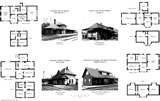Stations
The standard combination of office freight, passenger and living areas in one building—usually a two-story structure to separate living quarters from business operations—became the norm, able to satisfy the business requirements of the company and the housing needs of the mostly married agent-operators.2 Married men were considered to be more stable and responsible than single men.3
These standardized stations were economical to build and designed to encourage efficent operation, and the flexibility of the layouts allowed for expansion.4 Standard styles and colour schemes reinforced a railway company’s corporate identity.5
Each company had a variety of station classes, the size of a station being dependent on the importance and traffic needs of the community it served. Popular designs were seen in the Canadian Pacific’s Standard No. 5, the Canadian Northern’s Third Class, and the Grand Trunk Pacific’s ubiquitous Type A.
With the arrival of the truck and automobile, and the subsequent rationalization of the railway network, the once familiar station is fast disappearing. Only a few stations, not in operational use, are being preserved and used for other purposes. Richards and MacKenzie in The Railway Station: A Social History best expressed their epitaph: The closing of the station intangibly but signficantly dimishes the spiritual life of a country and its people, for it brings down the curtain with devasting finality on a stage which has seen a thousand dramas, comic and tragic, played out and has mirrored the changing moods of the nation, has etched itself into the working lives of some, the emotional lives of others.6
Notes | Bibliography | Abbreviations
1. C.W. Bohi, Canadian National’s Western Depots (Don Mills: A Railfare Book, 1977), p. 15.2. H.R. Grant and C.W. Bohi, The Country Railroad Station in America (Boulder: Pruett Publishing Co., 1978), p. 126.
3. Ibid., p. 128.
4. John R. Stilgoe, Metropolitan Corrido (New Haven: Yale University Press, 1983), p. 202.
5. Ibid., p. 203.
6. J. Richards and J.M. MacKenzie, The Railway Station (Oxford: Oxford University Press, 1986), p. 5.

